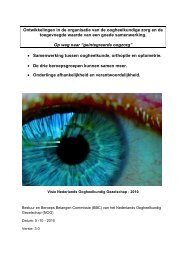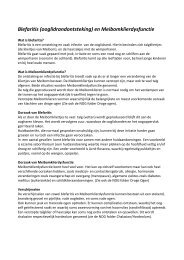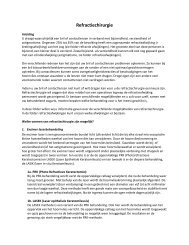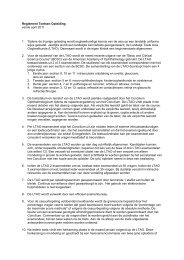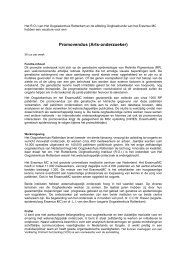terminology and guidelines for glaucoma ii - Kwaliteitskoepel
terminology and guidelines for glaucoma ii - Kwaliteitskoepel
terminology and guidelines for glaucoma ii - Kwaliteitskoepel
Create successful ePaper yourself
Turn your PDF publications into a flip-book with our unique Google optimized e-Paper software.
Signs <strong>and</strong> symptoms:<br />
No pain, no redness, corneal edema is possible<br />
IOP > 21 mm Hg<br />
Typical <strong>glaucoma</strong>tous optic nerve head <strong>and</strong> visual field damage if the disease is long-st<strong>and</strong>ing<br />
2.3.2.2 - Secondary Open-Angle Glaucoma due to ocular surgery <strong>and</strong> laser<br />
Ocular surgery can cause secondary open-angle <strong>glaucoma</strong> by some of the mechanisms discussed above: pigmentary loss<br />
from uveal tissue, lens material, haemorrhage, uveitis <strong>and</strong> trauma. See also ch.s 2.3.1.1 to 2.3.2.1<br />
Etiology: Reduced trabecular outflow<br />
Pathomechanism:<br />
• Viscoelastic materials, inflammatory debris, intra-operative application of alpha-chymotrypsin, lens particles,<br />
vitreous in the anterior chamber after cataract surgery, prostagl<strong>and</strong>in release. IOP elevation is usually transient.<br />
• Acute onset secondary IOP elevation after Nd:YAG laser iridotomy, capsulotomy <strong>and</strong> argon laser trabeculoplasty.<br />
Usually transient, within the first 24 hours, most frequent in the first 4 hours after treatment.<br />
• Emulsion of silicone oil implanted intravitreally enters the anterior chamber <strong>and</strong> is partially phagocytosed by<br />
macrophages <strong>and</strong> accumulates in the trabecular meshwork (especially in the upper quadrant).<br />
• Uveitis -<strong>glaucoma</strong>- hyphema (UGH) syndrome. Episodic onset, associated with anterior chamber pseudophakia.<br />
IOP elevation is induced by recurrent iris root bleeding <strong>and</strong> anterior uveitis.<br />
Features:<br />
Sign <strong>and</strong> symptoms:<br />
Pain, redness, corneal edema are possible<br />
IOP > 21 mm Hg<br />
Visual field loss when IOP elevation is sufficient/prolonged<br />
2.3.3 - SECONDARY OPEN-ANGLE GLAUCOMA CAUSED BY EXTRAOCULAR CONDITIONS<br />
2.3.3.1 - Glaucoma caused by increased episcleral venous pressure<br />
Etiology: Increase of the episcleral venous pressure which causes reduced trabecular outflow <strong>and</strong><br />
elevated intraocular pressure<br />
Pathomechanism: Episcleral, orbital or general causes <strong>for</strong> reduced episcleral venous outflow:<br />
* Dural shunts<br />
* Chemical burn, radiation damage of the episcleral veins<br />
* Endocrine orbitopathy<br />
* Orbital (retrobulbar) tumour, pseudotumour,<br />
* Orbital phlebitis<br />
* Orbital or intracranial arteriovenous fistula<br />
* Sturge-Weber syndrome<br />
* Nevus of Ota<br />
* Cavernous sinus thrombosis<br />
* Jugular vein obstruction (radical neck dissections)<br />
* Superior vena cava obstruction<br />
* Pulmonary venous obstruction<br />
* Idiopathic <strong>for</strong>ms<br />
Features:<br />
Onset can be acute<br />
Signs <strong>and</strong> symptoms:<br />
Wide variations of clinical features<br />
IOP > 21 mm Hg<br />
Dilated, congested episcleral veins, chemosis, facial lymphoedema, orbital bruit<br />
Vascular bruits in case of A/V fistulae<br />
Ch. 2 - 12 EGS



